https://visionsunboundstudio.etsy.com 🚀 Cosmic Visions Space Art & Celestial Landscapes ✨ Exploring the beauty of the cosmos through AI-generated art. From nebulae to distant galaxies, experience breathtaking celestial visions crafted by machine learning. 🔹 No Reuse or Redistribution All images are original generated works created for artistic exploration. Unauthorized use, reproduction, or modification is strictly prohibited. If you wish to use or license any artwork, please contact us directly. 🌌 Follow for new celestial creations daily! #AIArt #SpaceArt #DigitalCosmos #SciFiLandscapes #GenerativeArt
Don't wanna be here? Send us removal request.
Photo
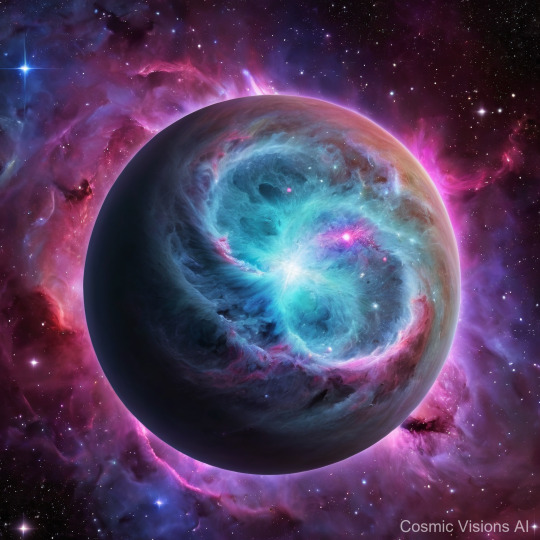
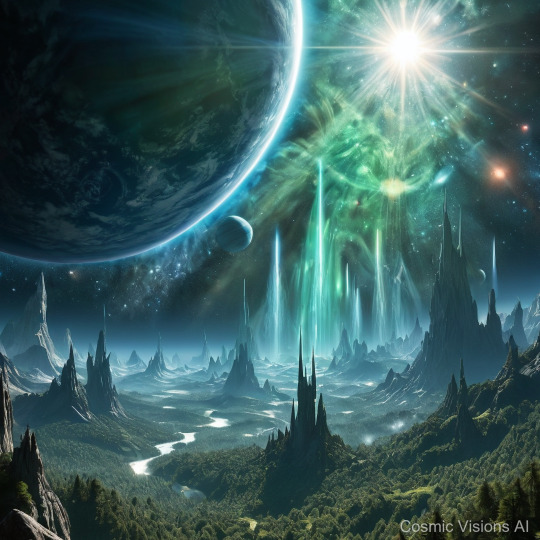
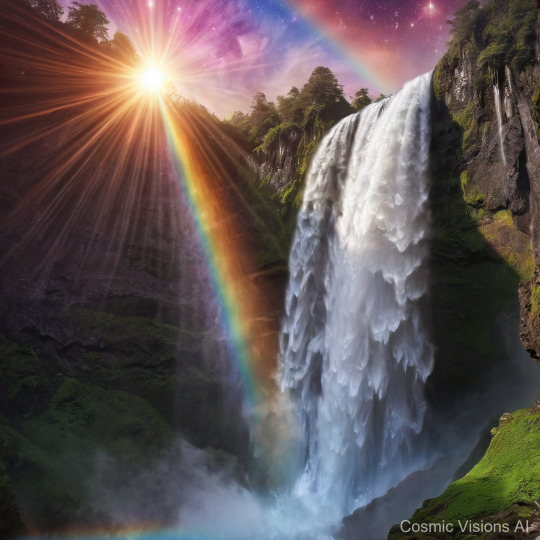
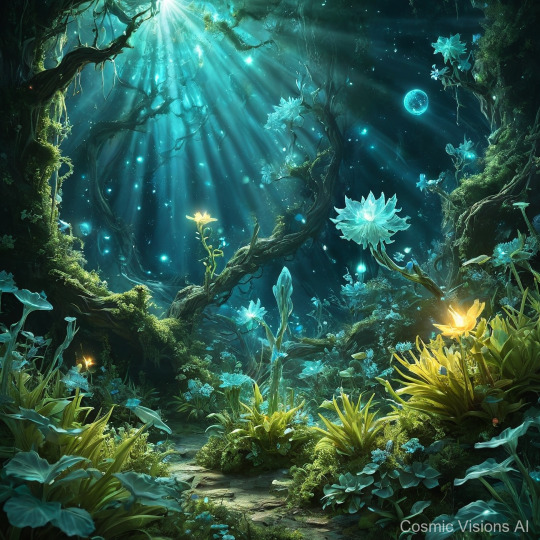
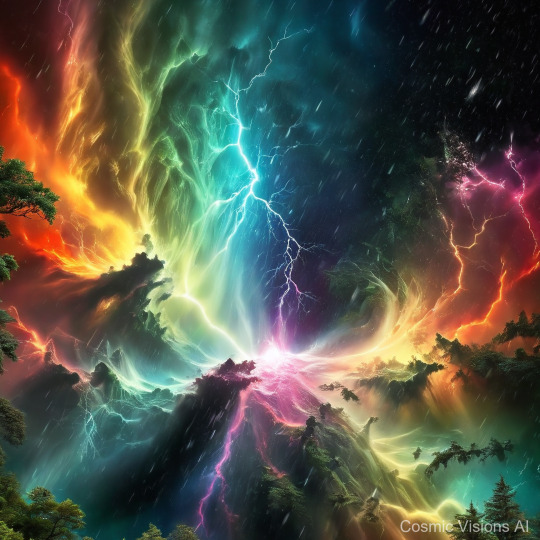
Planet Xypherion, viewed from space, appears veiled in shimmering turquoise hues, a consequence of its rich crystal-infused atmosphere. This unique atmospheric composition scatters blue and green wavelengths, creating an ethereal glow that can be seen from orbit. The planet's size is moderately larger than Earth, which allows for an extensive and diverse topography. Surfacescapes on Xypherion are dominated by vast forests of towering crystalline structures. These 'trees'—rigid, translucent columns—soar up to 50 meters in height, forming canopies that glint under the planet’s twin suns. The reflection of solar rays off these crystal canopies produces a spectrum of dazzling light effects, and also seems to energize the dense mist that perpetually hangs beneath them. The ambient light and humidity combine to create an otherworldly glow that permeates this mesmeric landscape, hinting at complex ecological dynamics yet to be understood.
#CrystalineForestCanopy#SpacePhotography#GalacticGems#AstralFoliage#CelestialJungle#NebulaFlora#StarryCanopy#CosmicTrees#GemstoneForest#AstroBotany
0 notes
Photo
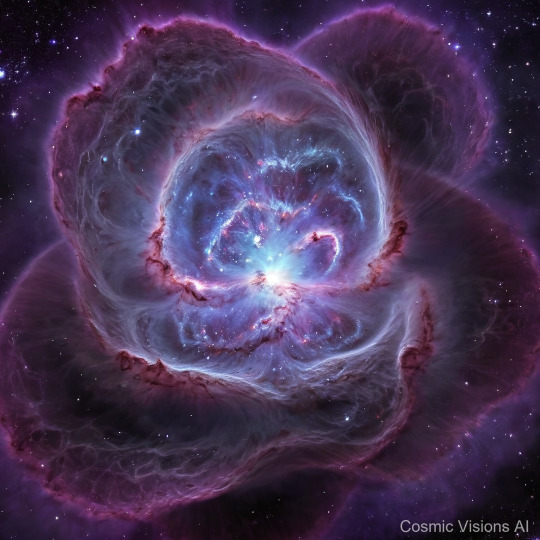
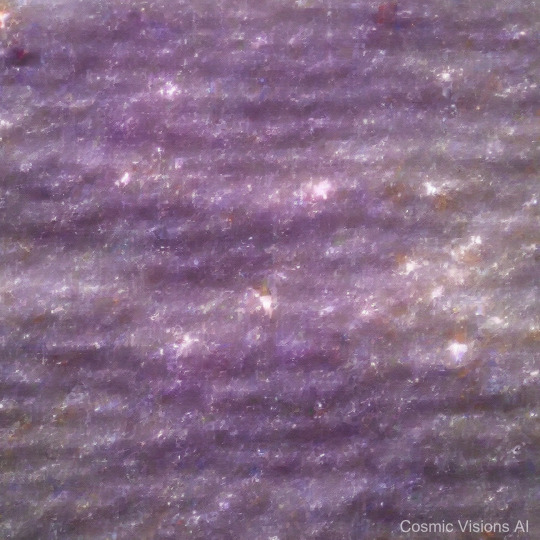
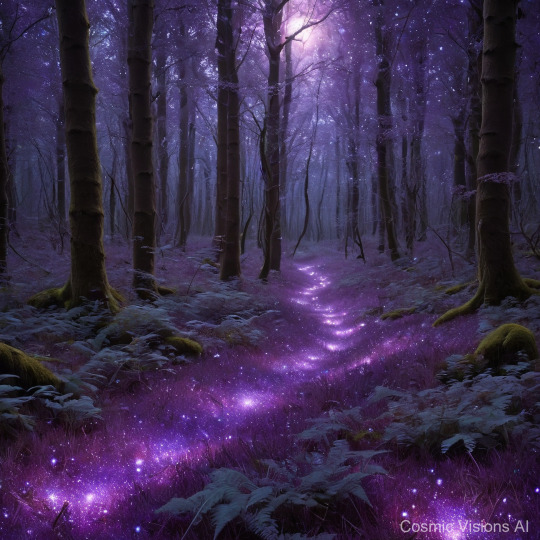
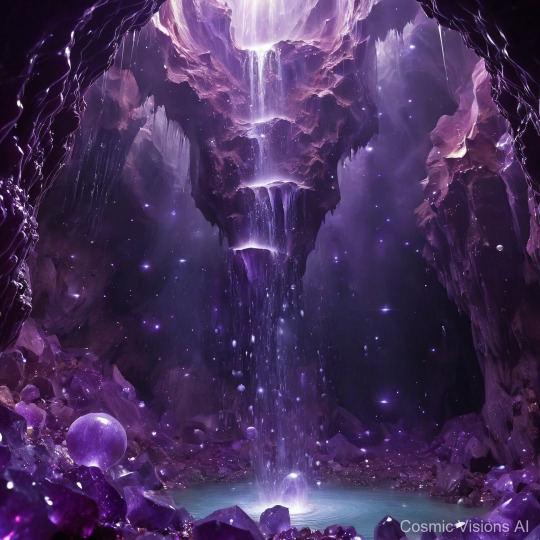
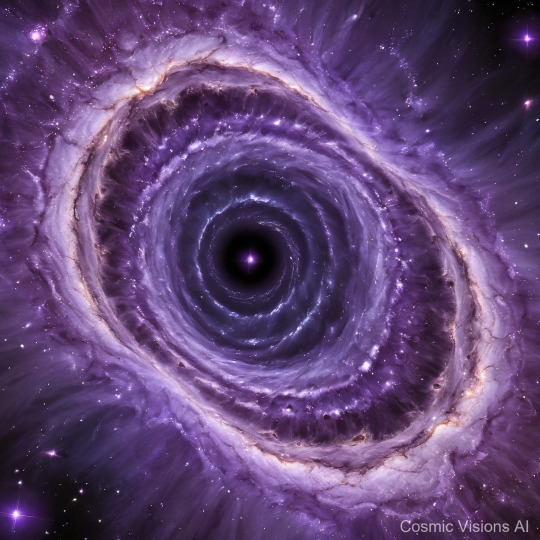
Planet Obsidia, observed from space, appears as a shimmering violet orb enveloped in thin, silvery clouds. Its size, slightly smaller than that of Earth, possesses a unique atmospheric composition rich in argon and neon, giving it its distinctive lavender glow. This planet is famed for its extensive network of surface caverns filled with vast deposits of amethyst-like crystals that refract light and create luminous, surreal landscapes. The surface conditions of Obsidia are harsh with temperatures fluctuating drastically due to its thin atmosphere. The crystal caverns, deep and sprawling, provide a stark contrast to the barren, rocky landscapes above. These caverns are characterized by their stable, cooler climate and their walls, which glitter intensely, range from deep indigos to bright lilac hues. These formations likely result from volcanic activities in the planet's past, combining high temperatures and rich mineral deposits to form the gem-like structures observed today. Each cavern is a natural vault of geological wonders, providing significant insight into the planet's geothermal and mineralogical history.
#VioletCrystalCaverns#GalacticGlow#SpaceGems#CelestialCaves#NebulaTrek#StellarStones#CosmicQuartz#AstralCrystals#DeepSpaceAdventures#LavenderLuminance
0 notes
Photo
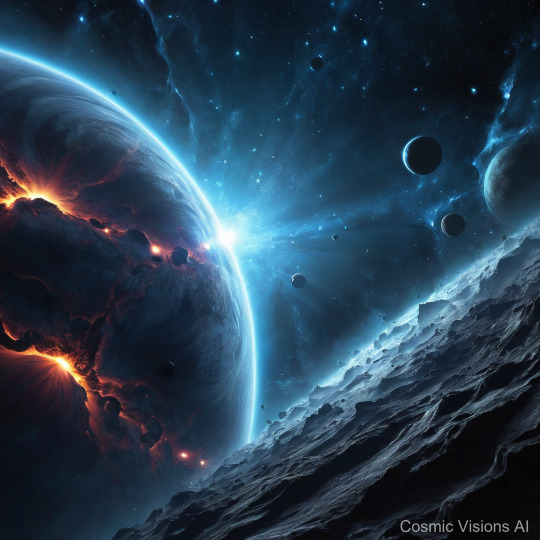
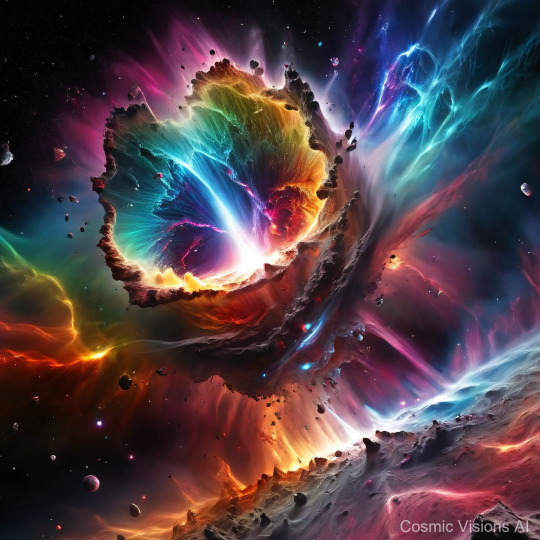
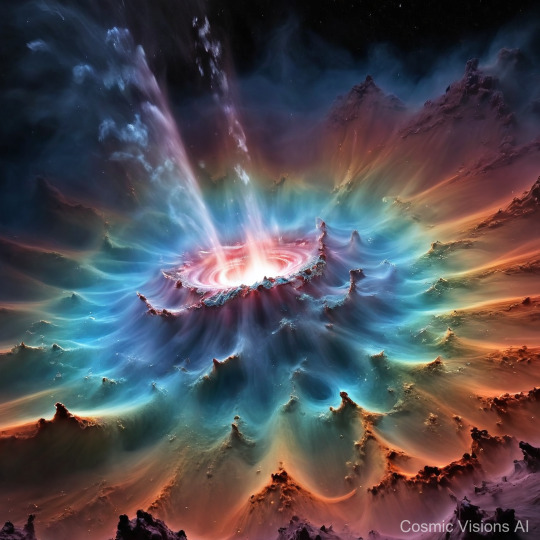
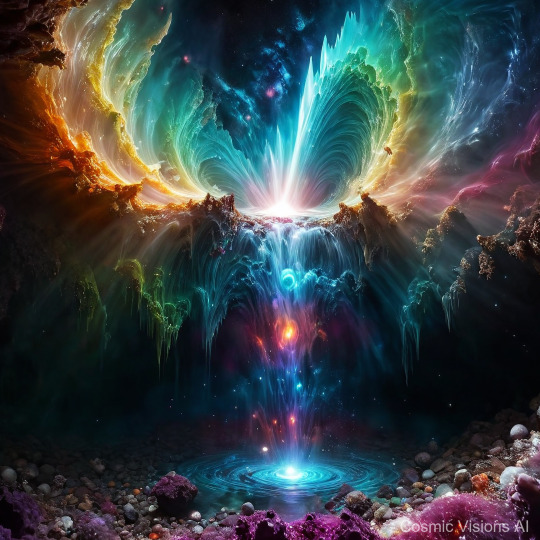
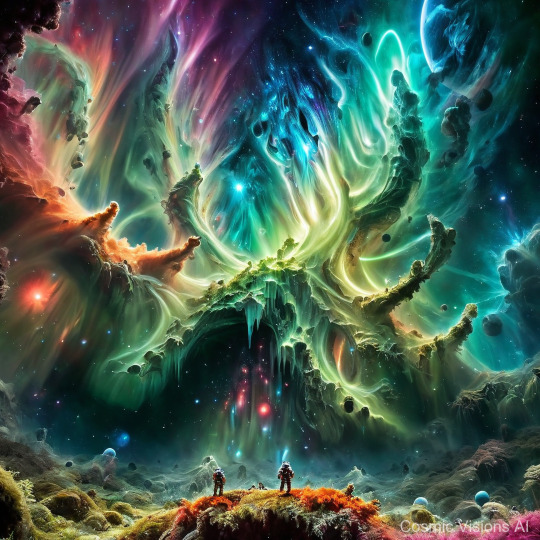
Planet Xyrenia, observed from space, appears as a mesmerizing swirl of teal and violet hues, enveloped in a thin mist of crystalline vapor. Despite its beauty, this planet boasts extreme surface conditions dominated by vast crystal caverns, formed due to intense volcanic activity and rich mineral deposits. The caverns themselves are a spectacle of natural architecture, with towering spires and jagged formations of luminous crystals that glow under Xyrenia's dim, flickering sun. These crystals, ranging from sharp azures to deep magentas, create a labyrinth of reflective surfaces, casting eerie lights and shadows. Frequent seismic shifts and volcanic eruptions continue to carve deeper into the planet’s crust, creating new passages and altering the labyrinthine maze within. The atmosphere inside these caverns, while thin, is composed of volatile gases that shimmer with a spectral brilliance, making Xyrenia a planet of both breathtaking beauty and perilous conditions.
#VolatileCrystalCaverns#SpaceGems#AsteroidCaves#GalacticMinerals#CosmicCrystals#NebulaCavities#CelestialGemstones#StellarGeodes#InterstellarLabyrinths#SphereofLight
0 notes
Photo
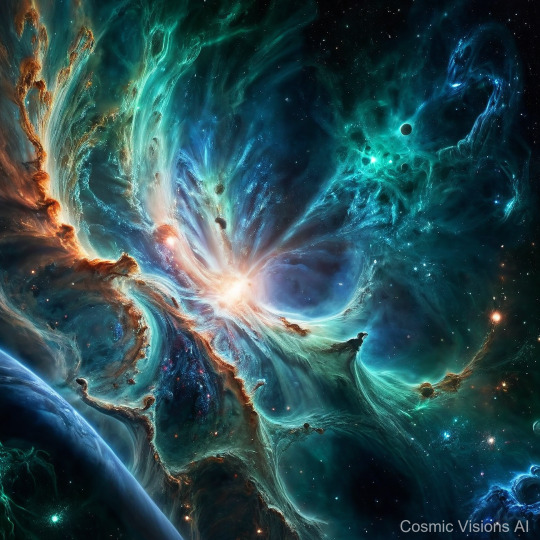
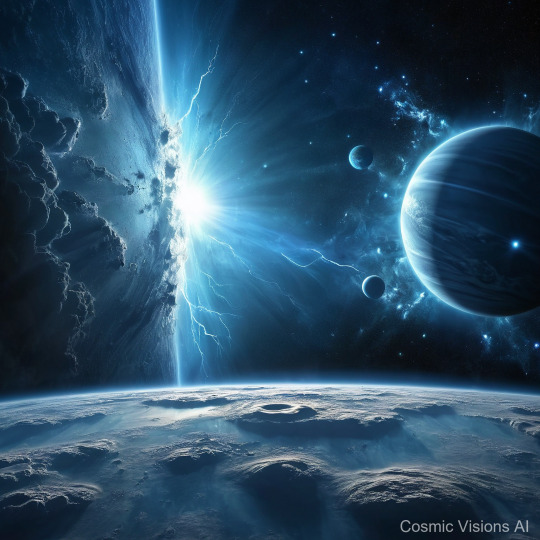
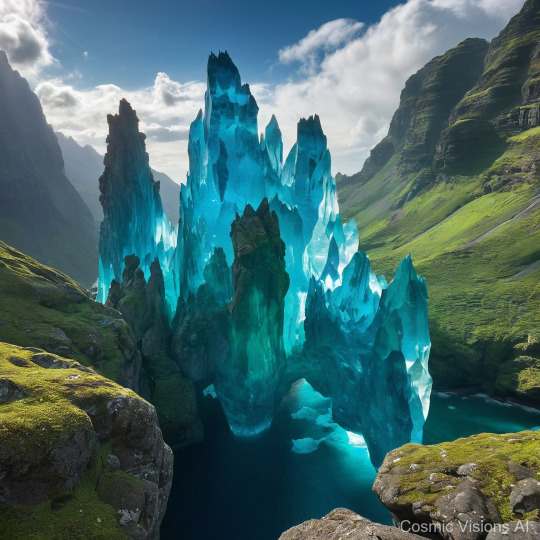
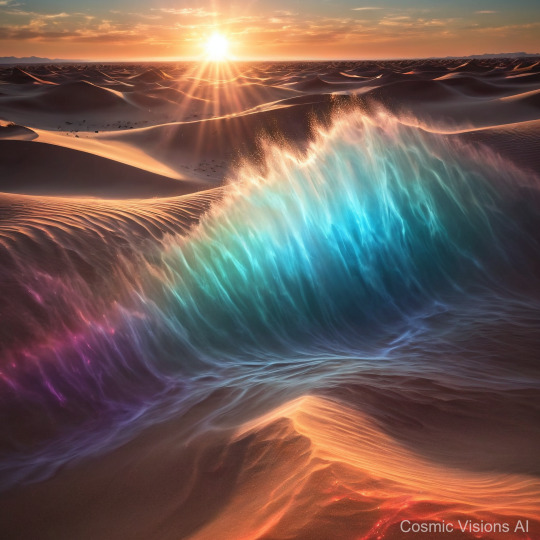
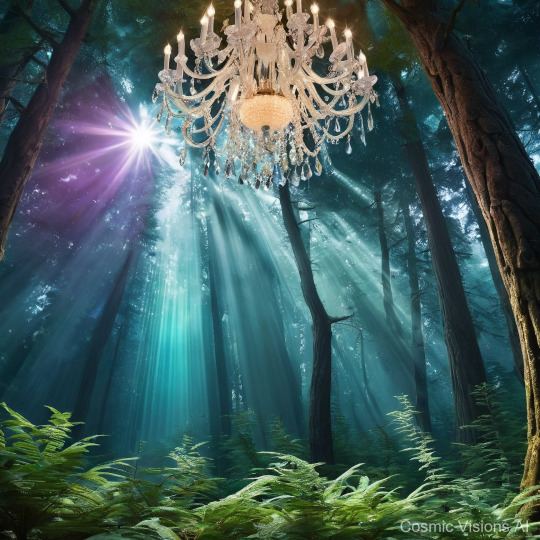
Planet Crystallon features an extraordinary atmosphere, dominated by 'Crystal Veil Clouds', which are composed of reflective silicate particles that shimmer brilliantly as they catch the starlight. This planet, slightly larger than Earth, glows softly from afar, its azure blue and silvery streaks creating an ethereal visual from orbit. These clouds have a metallic sheen, giving Crystallon an almost mirror-like appearance expanding across the globe. On its surface, Crystallon is riddled with vast, jagged landscapes of naturally formed crystal forests. These sparkling structures reflect not only the crystalline clouds above but also lend to extreme surface temperatures due to the heat retention properties of the silicate formations. The prevailing conditions are predominantly arid, with occasional bursts of crystal shard storms, where the high winds buffet against the fragile silicate, showering the ground with a stunning yet hazardous display of light and color. Crystallon’s extreme beauty is matched only by its potential for scientific study, holding secrets of mineral evolution and atmospheric phenomena.
#CrystalVeilClouds#DeepSpacePhotography#NebulaMagic#CelestialBeauty#GalacticWonder#AstronomyArt#SpaceNebulae#StarrySkies#CosmicFantasy#NebulaChasers
0 notes
Photo
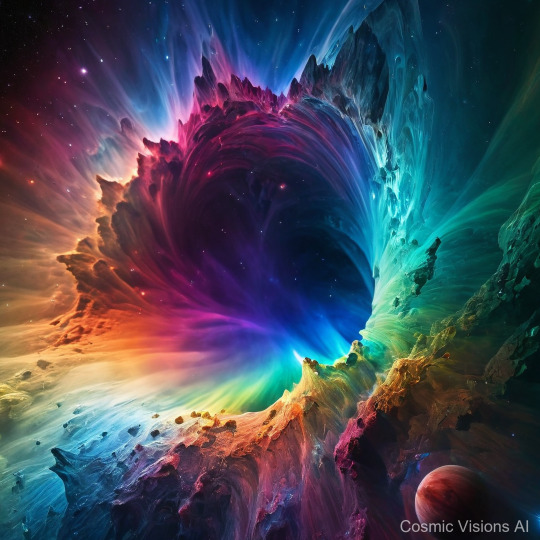
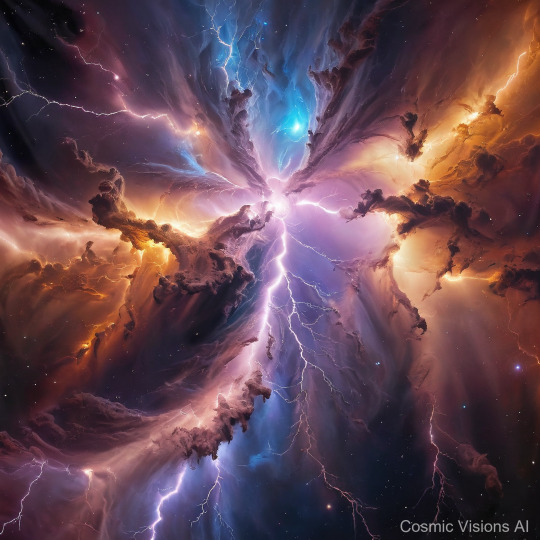
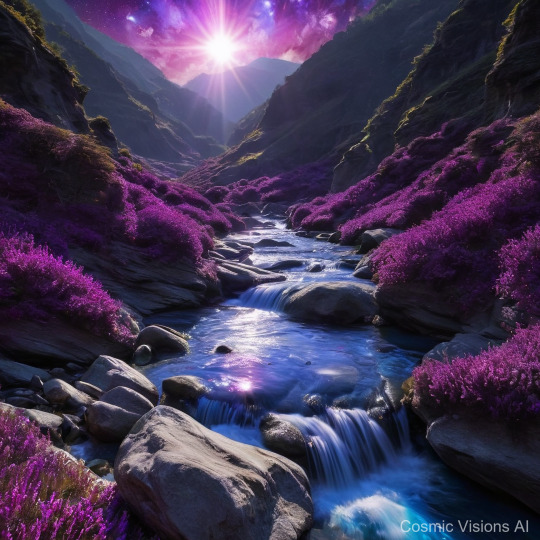
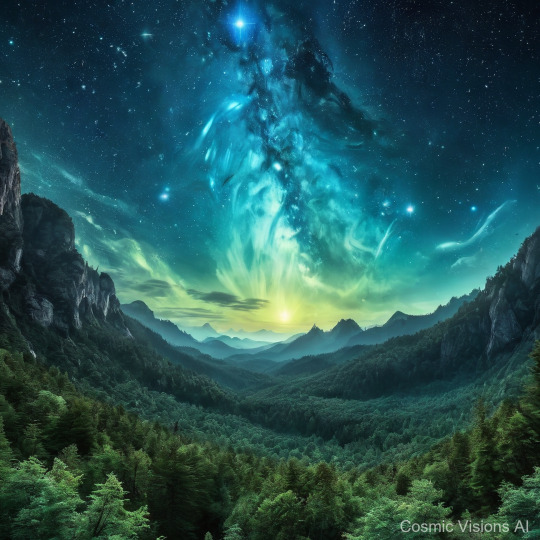
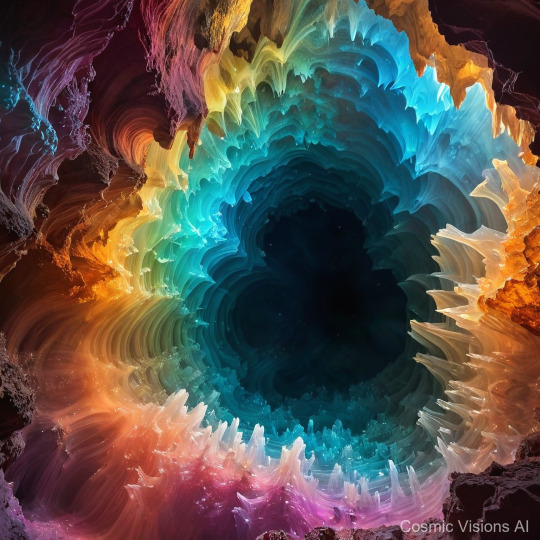
Planet Prismara, observed from space, exhibits a stunning azure glow, hinting at its rich atmosphere composed primarily of helium and argon. Its size, slightly smaller than Neptune, allows for a surface characterized by vast prismatic crystal caverns, a unique feature across its otherwise rocky terrain. Surface explorations reveal that these caverns, formed over millennia, reflect and refract light into dazzling displays due to their crystalline structures, comprised chiefly of beryllium silicate. The caverns range from shallow grottoes to extensive subterranean networks, creating a labyrinth of light and color. Weather conditions on Prismara often involve mild electrical storms, which interact with the crystal formations, producing spectacular light shows that illumine the planet's nightscape. These phenomena make Prismara a unique subject of study regarding photonic interactions in alien geology.
#PrismaticCrystalCaverns#SpaceGems#GalacticWonder#CrystalCaveExploration#CelestialCrystals#AstralCaverns#StellarGeology#NebulaCrystals#CosmicHues#DeepSpaceTreasures
0 notes
Photo
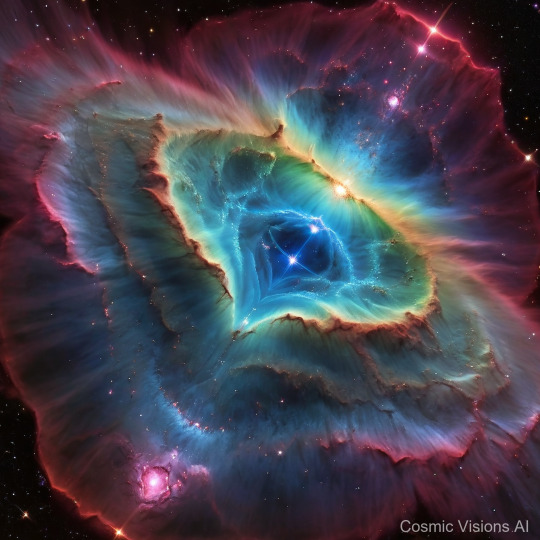
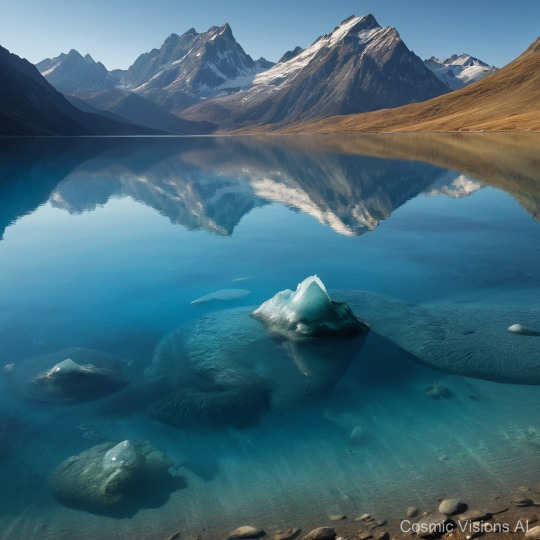
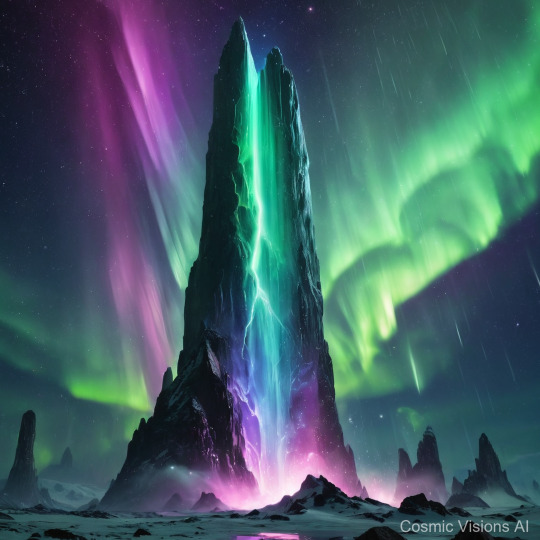
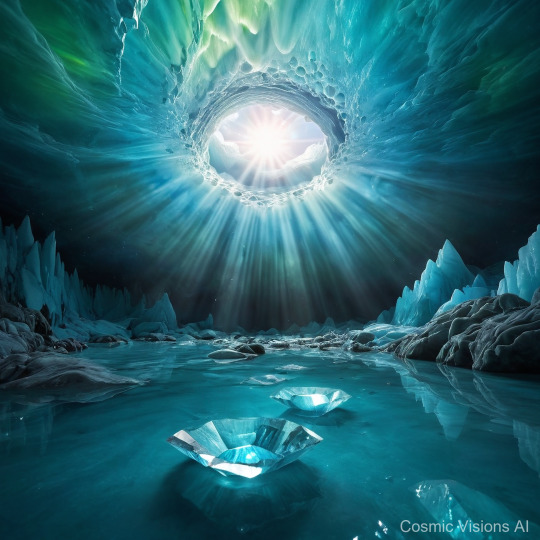
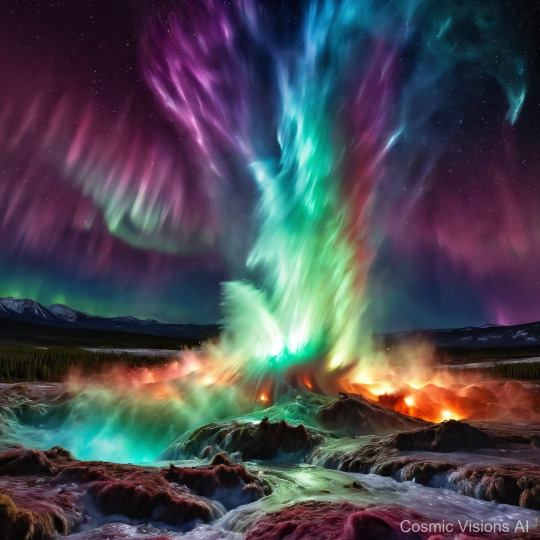
Planet Vespera, as observed from orbit, presents itself with a striking azure hue, interspersed with swirling patterns of darker blue and intermittent flashes of bright, diamond-like reflections. Its atmosphere comprises dense, crystalline clouds that scatter incoming starlight, creating the spectacular phenomenon known as Diamond Aurora Skies. This luminescent event appears to imbue the entire planet with a celestial glow, especially during its long twilight periods. Surface explorations, remotely conducted through rovers, reveal a rugged terrain predominantly covered in fine, silvery dust and punctuated by sharp, glassy ridges. These ridges are thought to be largely composed of various silicates and carbon compounds under immense environmental pressures, contributing to their reflective quality. Temperature readings suggest extreme variations, which alongside frequent and intense photonic storms, indicate a dynamically unstable atmosphere. Such conditions make Vespera a challenging yet fascinating subject for astrophysical and atmospheric studies.
#DiamondAuroraSkies#SpaceGems#CelestialBeauty#GalacticLights#StarryWonder#AuroraPhotography#AstroPhotography#NorthernLights#SpaceJewels#AstronomyArt
0 notes
Photo
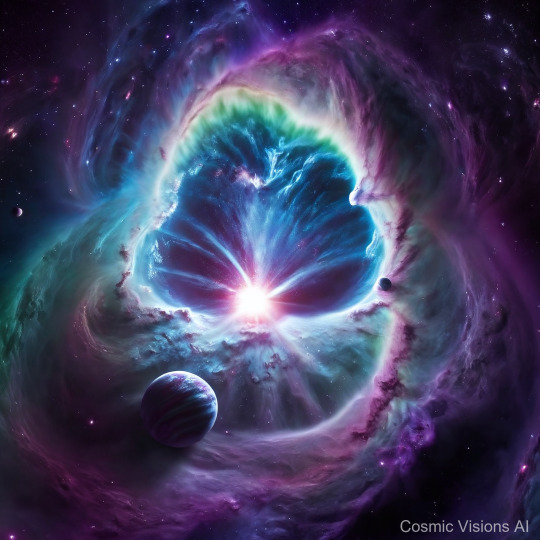
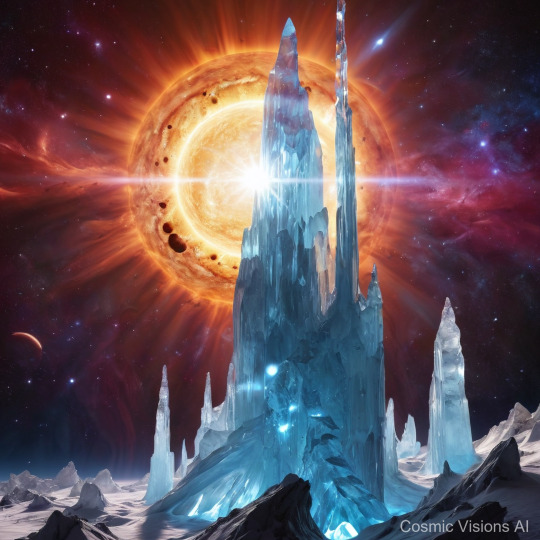
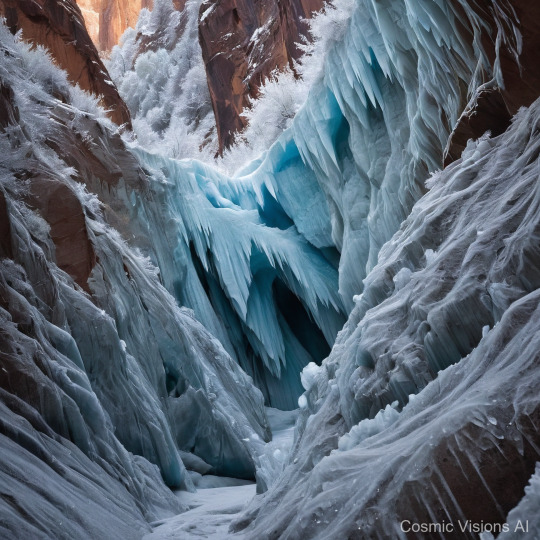
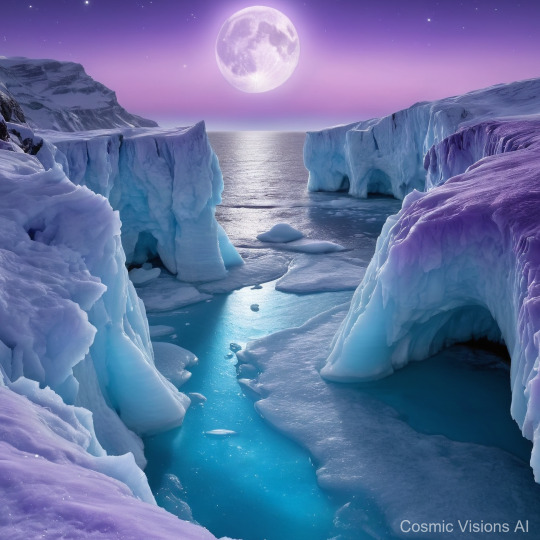
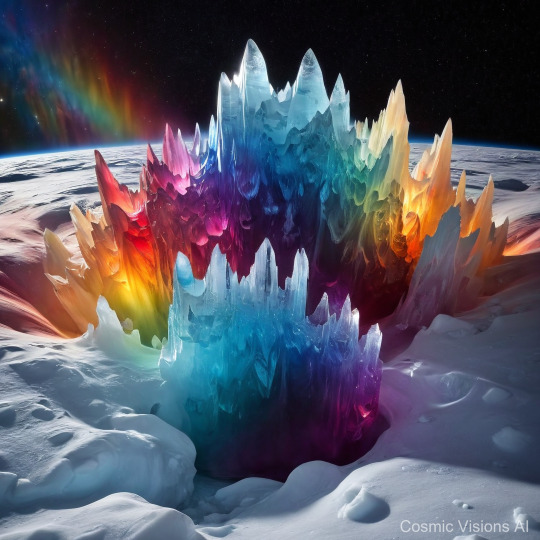
Planet Glaciox stands out in the cosmos as a striking celestial body. From space, it appears as a shimmering sphere enveloped in an azure haze, its surface adorned with sprawling crystal formations reflecting sunlight spectacularly. This planet is of notable size but possesses a thin atmosphere dominated by nitrogen and methane, which contributes to its extremely low surface temperatures and ethereal blue glow. The surface of Glaciox is a wonderland of crystal ice caverns which form an intricate network beneath its icy crust. These caverns are characterized by towering spires and delicate arches of transparent ice, faceted like gems, which scatter the scant sunlight into dazzling displays. Temperature inside these caverns can plummet, making their environment one of the most extreme within the known galaxy. These features position Glaciox as a prime subject for studying cryovolcanic activity and the formation of exotic ice structures in alien environments.
#CrystalIceCaverns#SpaceExploration#GalacticBeauty#IceFormations#DeepSpacePhotography#ExtraterrestrialWonders#BeyondTheStars#NebulaAdventures#FrozenGalaxies#CelestialSubzero
0 notes
Photo
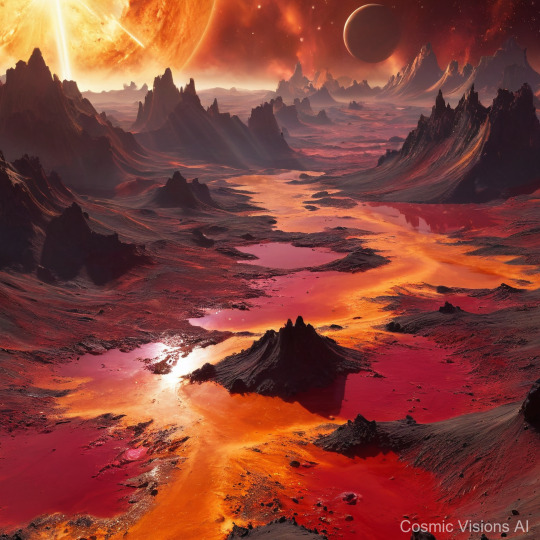
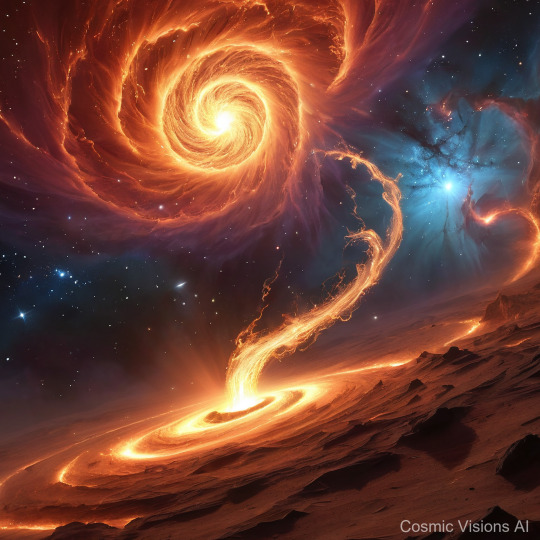
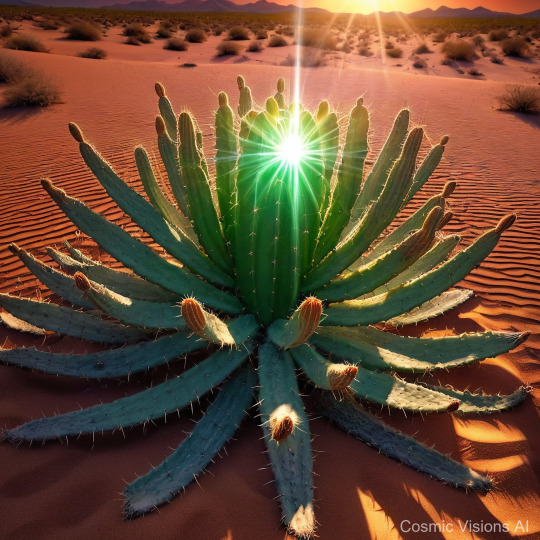
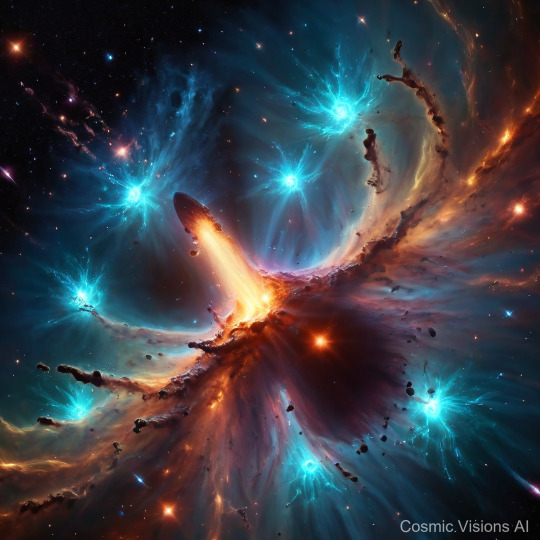
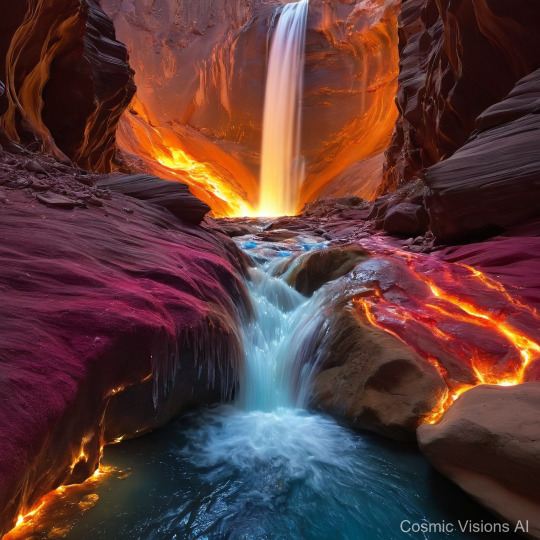
Pyrocrystalis, a medium-sized planet visible from space by its radiant glow, exhibits a stunning yet daunting landscape. Its atmosphere, thick with silica dust particles, reflects a fiery orange hue, hinting at the extreme surface conditions below. The planet’s dominant feature, the Fiery Crystal Desert, glistens under a relentless twin sun system. Here, towering spires of crystalline structures rise from the molten silica bedrock, formed by centuries of high temperatures which regularly exceed 500 degrees Celsius. Surveys of Pyrocrystalis reveal that these crystals, mostly comprised of silicon dioxide, vary in color from deep amber to fiery red, creating a mesmerizing, albeit searing landscape. Frequent solar flares exacerbate the planet's surface heat, occasionally causing spectacular light shows as they interact with the crystalline formations. Despite its harsh conditions, the Fiery Crystal Desert is a study in the beauty and complexity of geothermal evolutionary processes, offering a luminous yet untouchable vista.
#FieryCrystalDesert#SpaceGems#GalacticLandscape#AstronomyArt#CelestialBeauty#SpaceJewels#StellarSands#OuterSpaceOasis#CosmicMirage#NebulaDreamscape
1 note
·
View note
Photo
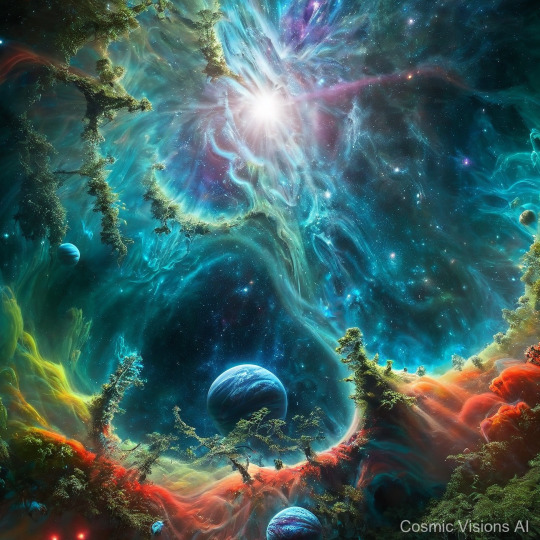
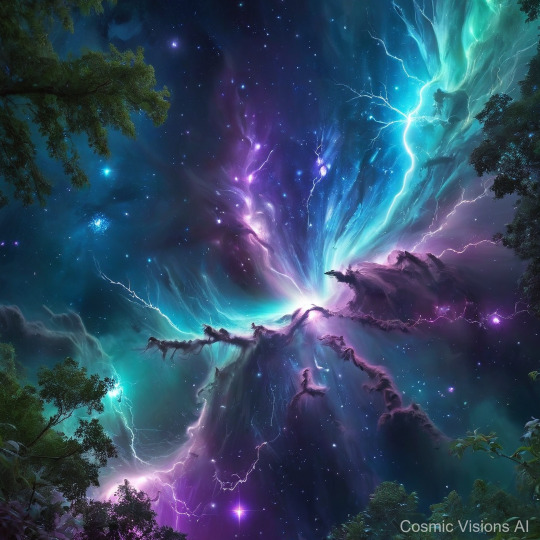
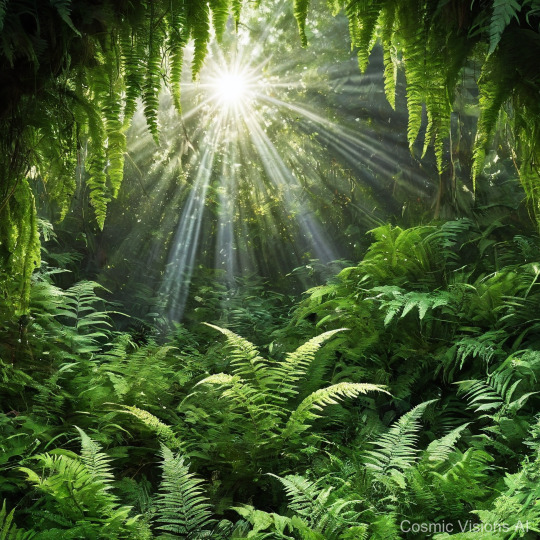
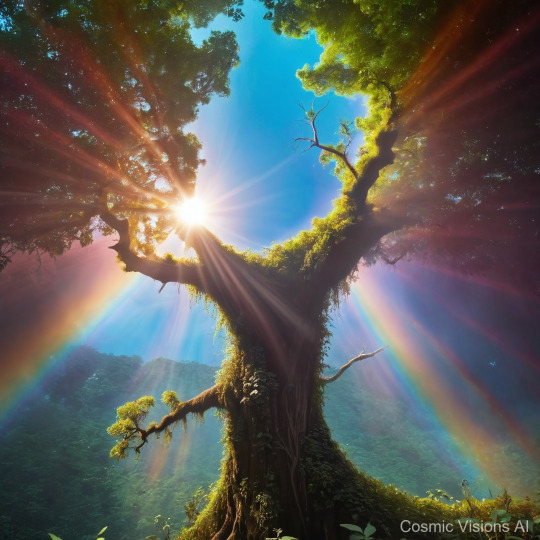
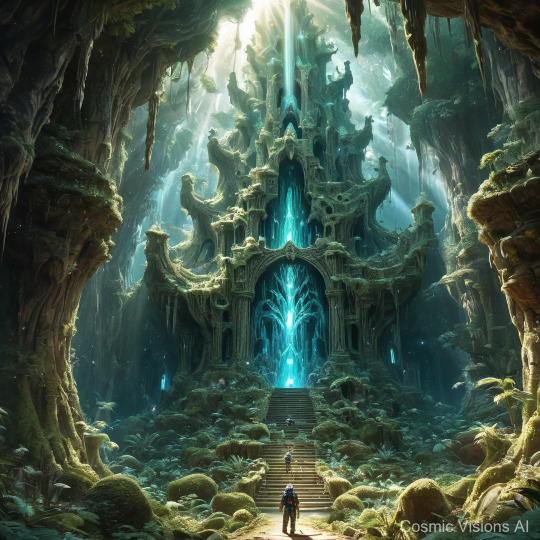
Planet Crystallon, a mesmerizing world enveloped in a shimmering azure atmosphere, is slightly larger than Earth and distinctly characterized by its crystalline surface structures. From space, Crystallon presents a radiant spectacle of interconnected crystal canopies that reflect and refract its twin suns’ lights, giving it a brilliant, sparkling appearance. The surface is dominated by vast jungles of towering crystal trees, some reaching up to a kilometer in height. These translucent structures create a multi-layered canopy that covers much of the planet. Beneath this gleaming expanse, a dense mist circulates, created by the mild, stable climate which seldom sees extremes, maintaining a consistent temperature amenable to the growth of the crystal flora. Intricate root systems of crystals dig deep into the rich mineral soil, absorbing not just water but various luminous elements that contribute to their radiant glow. This unique botanical phenomenon makes Crystallon a dazzling jewel in the cosmos, offering a landscape of breathtaking, otherworldly beauty.
#CrystalJungleCanopy#SpaceJungle#GalacticFlora#NebulaCanopy#StarlitForest#CelestialCanopy#AlienFoliage#NebulaGardens#SpaceExploration#AstronomyPhotography
0 notes
Photo
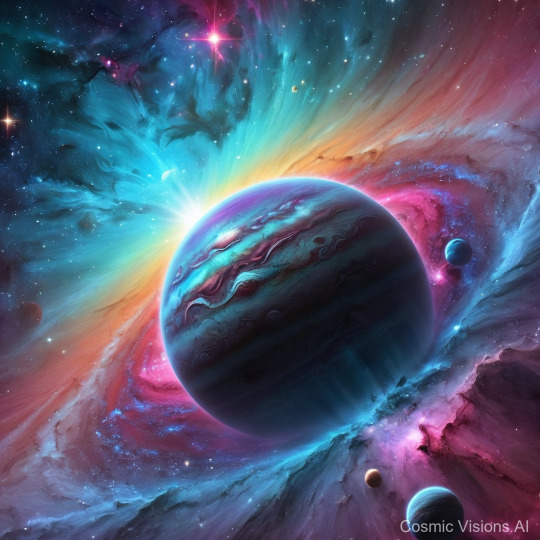
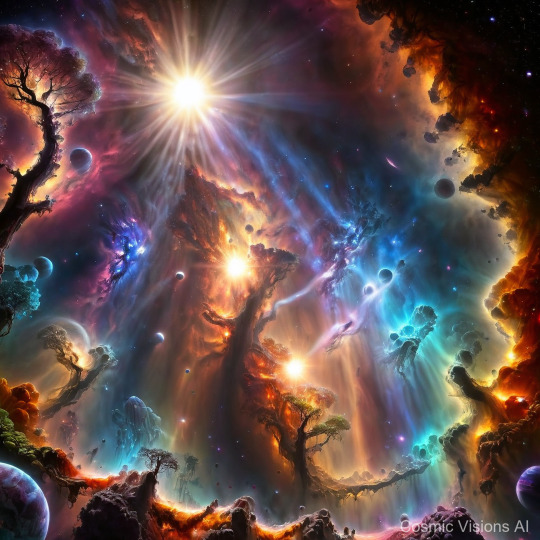
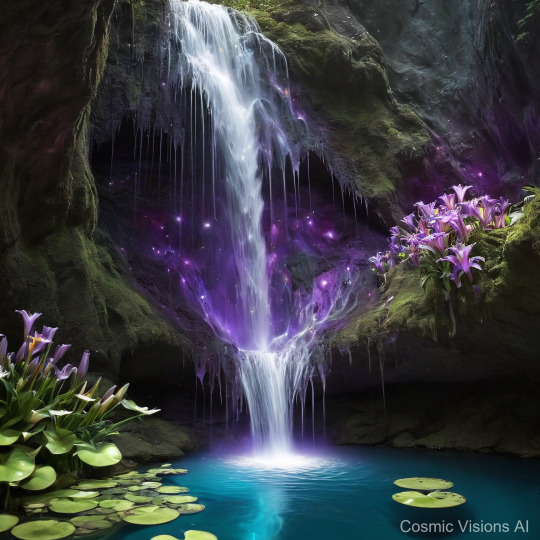
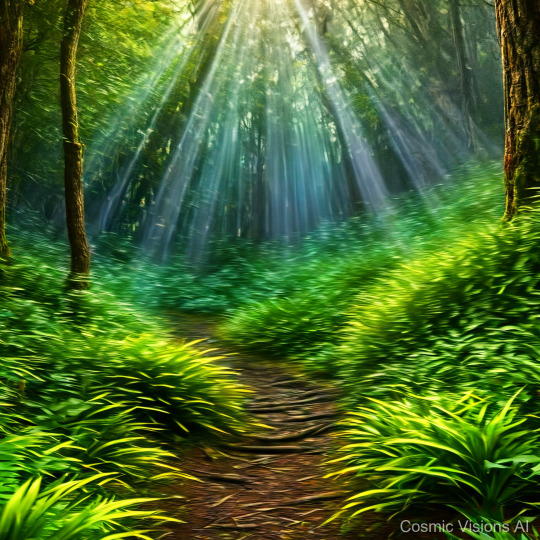
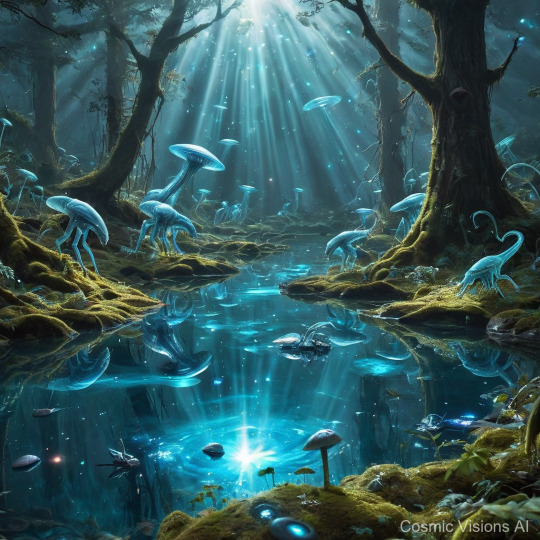
Planet Xytheris, observed from space, resembles a sparkling jewel, its expanse shimmering hues of mauve and emerald, enveloped by a thick, opalescent atmosphere. This unique atmospheric composition rich in silicate particles scatters light to create a constant iridescent glow visible from orbit. The surface of Xytheris is dominated by vast rainforests, but unlike any terrestrial counterpart. Here, towering crystal-like trees form dense canopies, their surfaces constantly shifting in color due to refractive light phenomena. Rainfall on Xytheris is both a climatic event and a visual spectacle; the precipitation is composed of liquid silicates that cascade through the foliage, pooling into luminescent lakes and rivers that glow with radiant light. Meteorological studies indicate that these silicate rains enhance the iridescence of the biome, with each droplet acting as a prism, fracturing light into mesmerizing patterns. This interaction between hydrosphere and biosphere creates an ecosystem of dazzling complexity, suggesting a planet rich in both mineral wealth and possibly, unique forms of crystalline plant life.
#IridescentCrystalRainforest#SpaceJungle#GalacticFlora#CelestialFoliage#NebulaVegetation#StellarBotany#AstronomyArt#CosmicBeauty#OuterWorlds#InterstellarGardens
0 notes
Photo
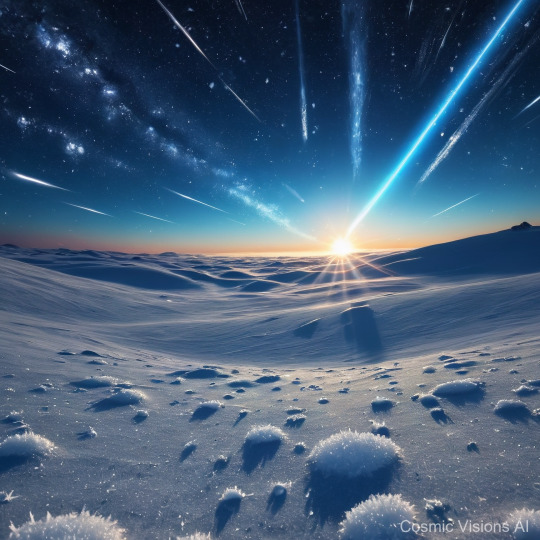
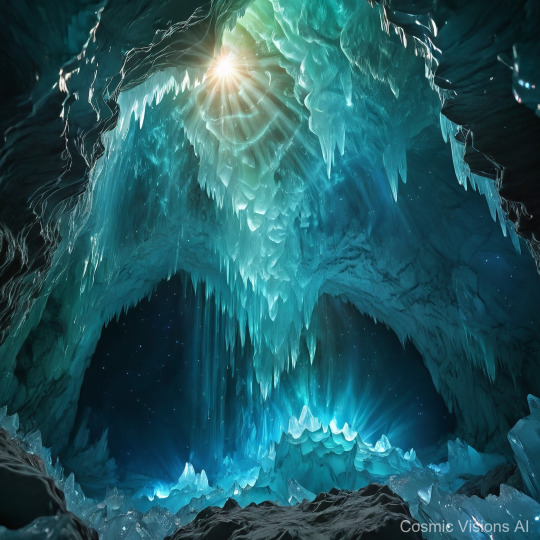
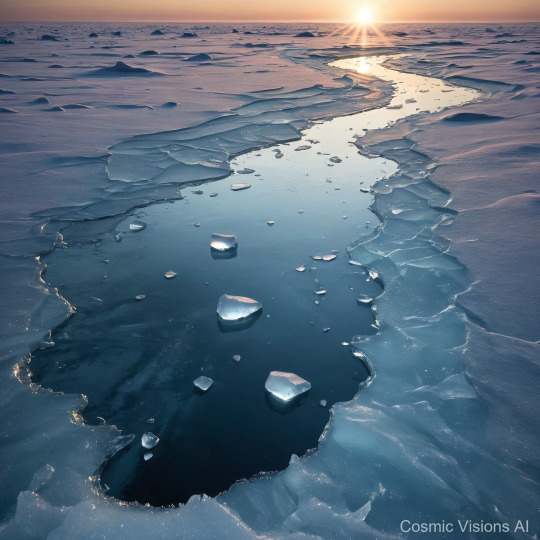
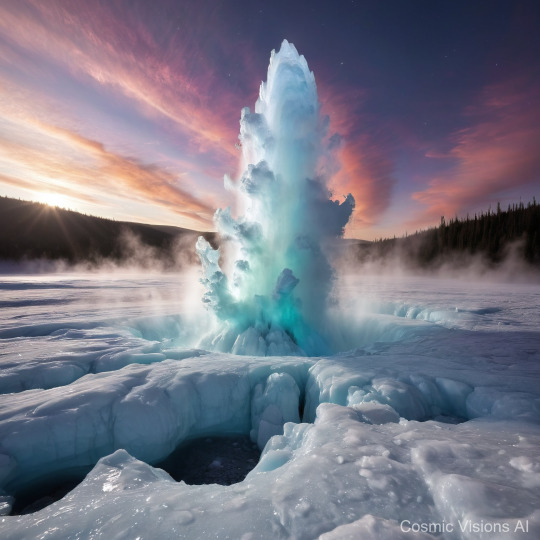
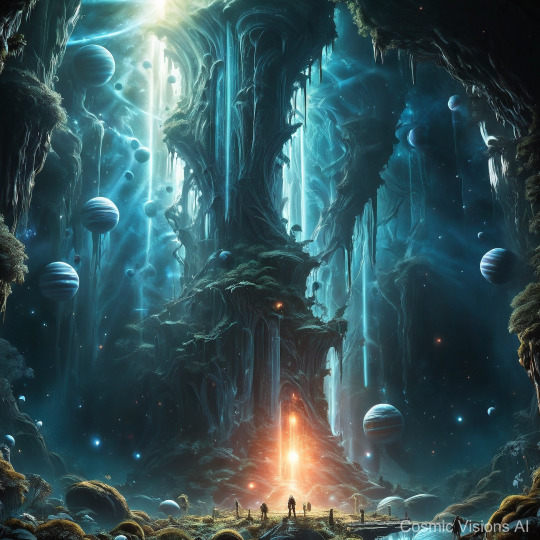
Planet Crystallix is a remarkable celestial body characterized by its translucent, pale blue hue and dense, frost-laden atmosphere observable from space. This frigid planet is enveloped in unending winter, teetering near the edge of its star system where sunlight struggles to penetrate the icy sheath encasing it. Its surface features a labyrinth of crystal ice caverns, forged by aeons of geological churn and subzero temperatures. The caverns are vast, glittering with iridescent ice that casts ghostly shimmers against their smooth, curved walls. These formations, some towering several kilometers high, are sculpted by the relentless winds that sweep across Crystallix's frozen tundra. The atmospheric conditions maintain a consistent -200 degrees Celsius, a testament to the planet's extreme climate adaptability. This extreme cold and the intricate crystal formations create an otherworldly landscape, a frozen tableau untouched by traditional planetary development processes.
#CrystalIceCaverns#SpaceExploration#CosmicBeauty#FrozenGalaxy#IceFormation#AstronomyArt#GalacticWonder#CelestialWonders#IcyDepths#StellarPhenomenon
0 notes
Photo
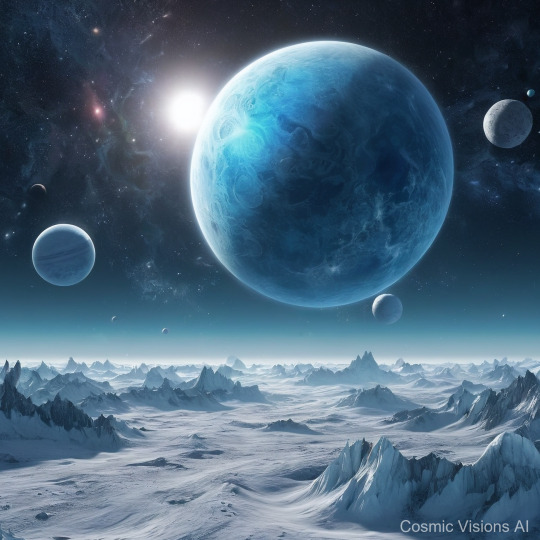
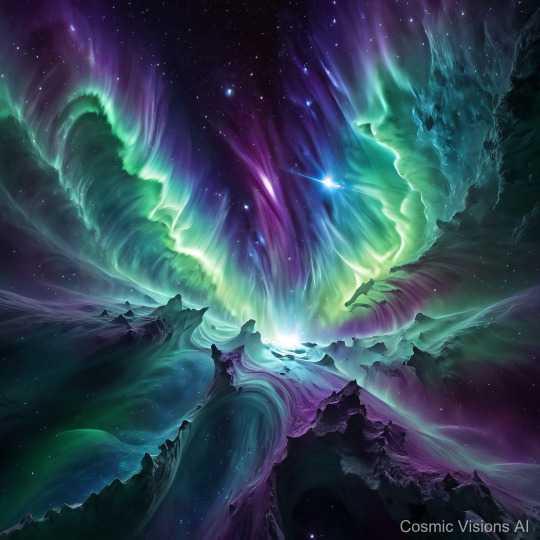
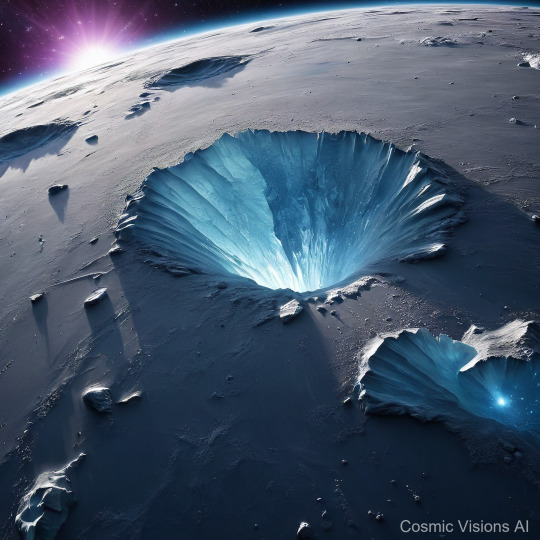
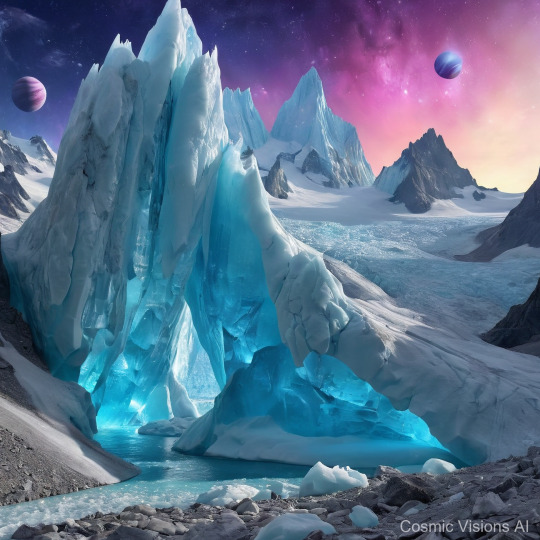
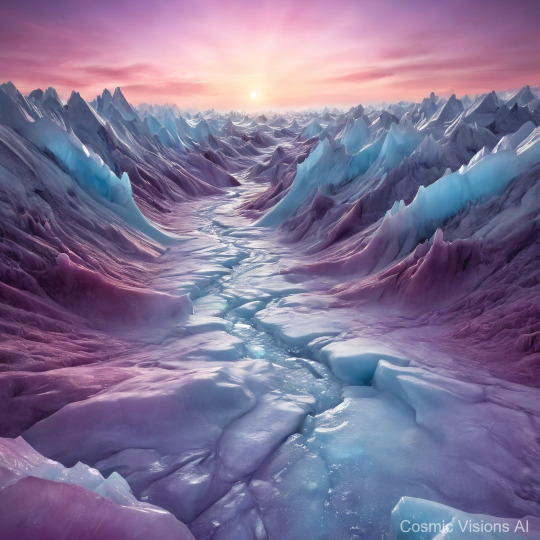
Planet Glaciaxion, observed from the cosmic expanse, reveals a striking azure and bluish-white palette, indicative of its vast icy surfaces and a thin, crisp atmosphere primarily composed of oxygen and argon. This orb, slightly smaller than Earth, is enveloped by swirling cloud formations that cast dynamic shadows across its frost-bound expanse. The surface of Glaciaxion is a spectacle of natural architecture, featuring towering glaciers predominantly composed of a unique, crystalline ice. This crystal, under the weak sunlight, whispers faintly as it expands and contracts, creating an eerie soundscape heard over the icy plains. The prevalent conditions include subzero temperatures and frequent, sharp winds that sculpt the ice into intricate formations resembling glass sculptures. These conditions have also formed deep crevasses and shimmering ice caverns, promising uncharted secrets beneath the frozen façade.
#WhisperingCrystalGlaciers#SpaceArt#GalacticIceFormations#CosmicPhotography#AstronomyArt#AstroArtistry#SpaceWhispers#CrystalGlacierWonders#StellarScenery#NebulaMagic
1 note
·
View note
Photo
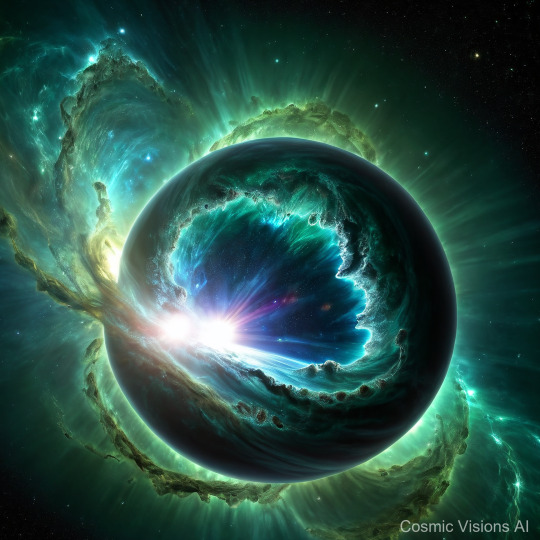
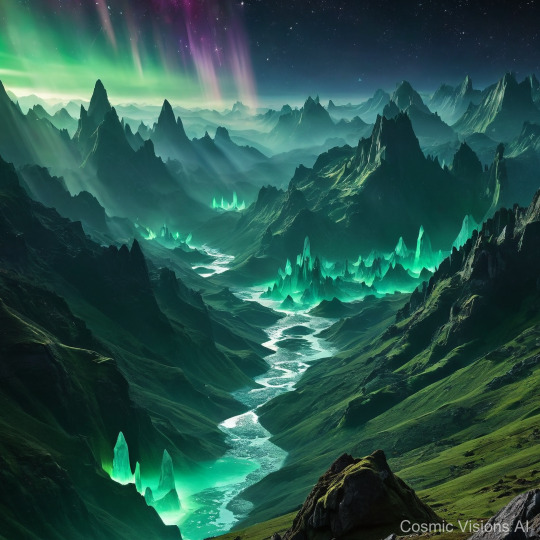
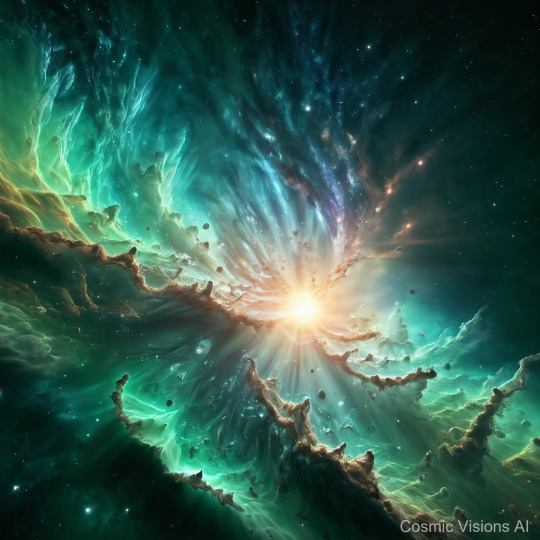
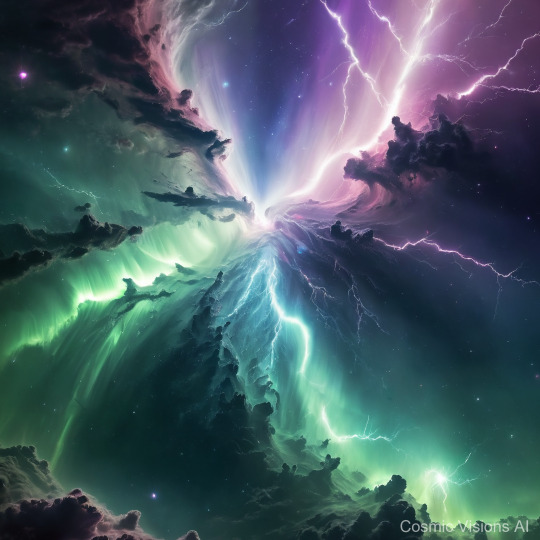
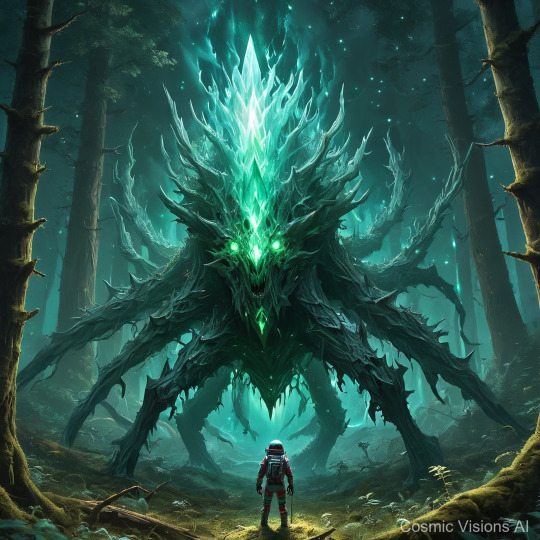
Planet Xylophar, notable for its distinct viridian hue, appears from space as an enigmatic emerald orb, swathed in diaphanous clouds. This visual spectacle owes much to its atmosphere, rich in methane and argon, casting a brilliant green glow off its expansive oceanic surfaces. The most striking features are the Viridian Crystal Caverns, exposed in several equatorial regions where geological upheaval breaches the crust. These caverns, formed from beryllium silicate compounds, shimmer under the planet's intense zodiacal lighting—creating an otherworldly luster that is visible even from orbit. Within these cavernous jewels, towering crystal formations create labyrinths reflecting the planet's faint solar light, suggesting conditions suitable for exotic forms of silicate-based life. Exposed to Xylophar’s tempestuous weather, characterized by fierce ion storms and incessant wind speeds, these structures defy their fragile appearance, enduring in stunning stoicism against the planet's harsh elements.
#ViridianCrystalCaverns#SpaceExploration#GalacticGems#AstronomyAdventures#CelestialWonders#CosmicBeauty#DeepSpacePhotography#StellarSpectacle#ExoplanetDiscovery#AlienLandscapes
1 note
·
View note
Photo
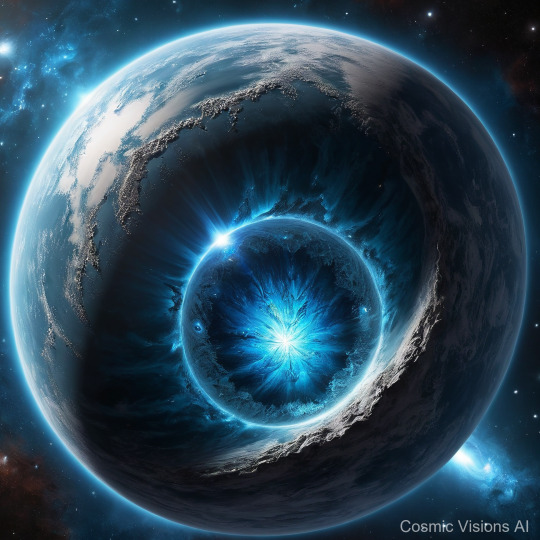
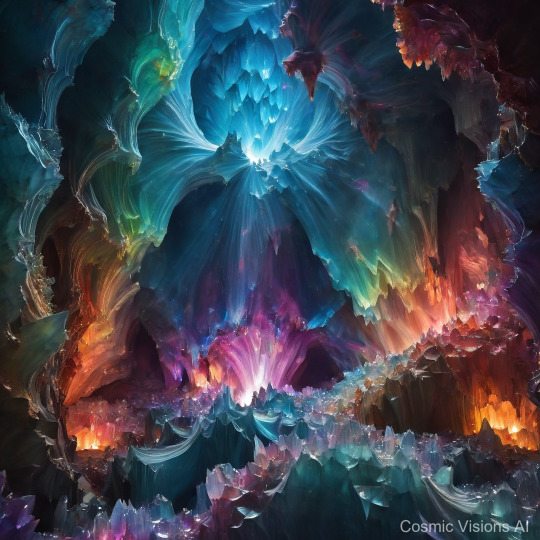
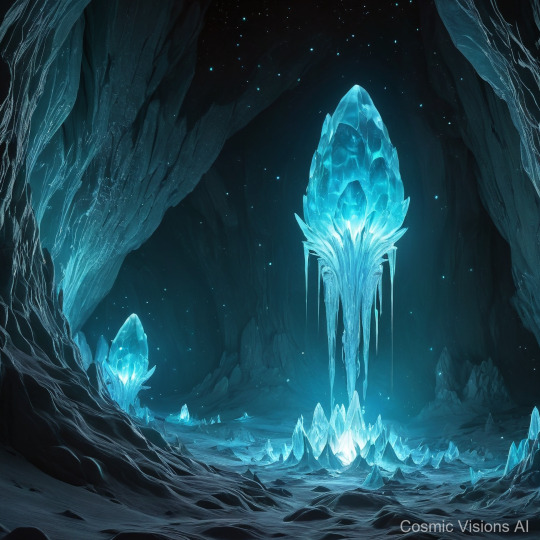
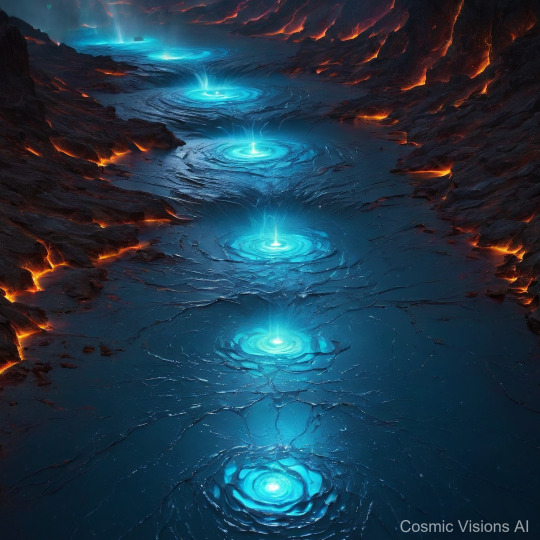
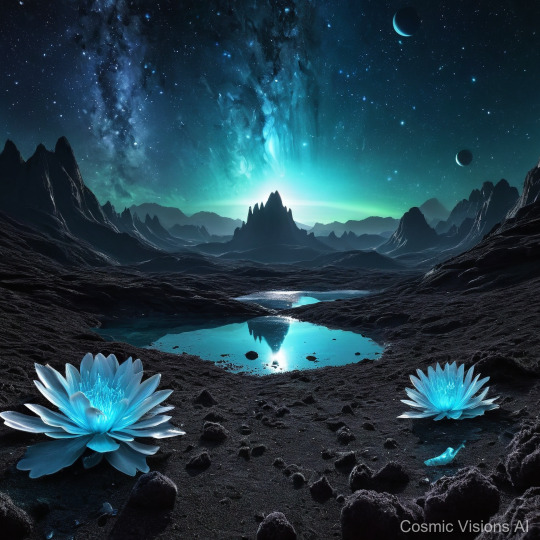
Planet Lumicrista, observed from space, appears as a radiant sapphire orb surrounded by a thin, shimmering atmosphere of pale azure. Its most striking features are the extensive glowing crystal caverns that permeate its rocky crust. Surface explorations reveal that these caverns consist of bioluminescent crystals, primarily in hues of deep purple and electric blue. The luminosity of these formations varies rhythmically, suggestive of an underlying geophysical or possibly biogenic mechanism. Aboveground, the planet is characterized by rugged, wind-swept terrains and a perpetually dim sky, lit mainly by the soft glow emanating from numerous surface fissures leading to the crystalline subterranean network. The atmosphere, though thin, accommodates violent, electrically charged storms that interact spectacularly with the crystal formations, often illuminating them in a dazzling display of natural light shows.
#GlowingCrystalCaverns#SpaceGems#CelestialCaves#CrystalCosmos#StellarGlow#GalacticBeauty#NebulaCrystals#AstronomyArt#SpaceExploration#DeepSpaceDiscovery
0 notes
Photo
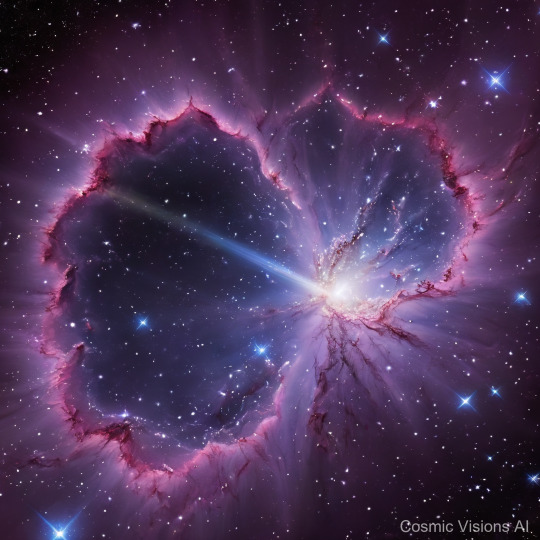
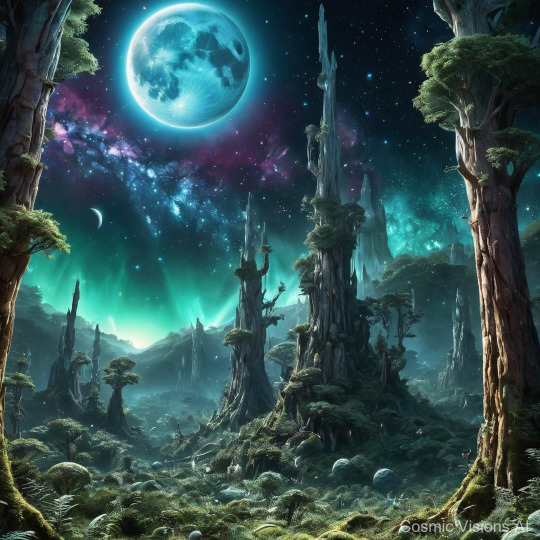
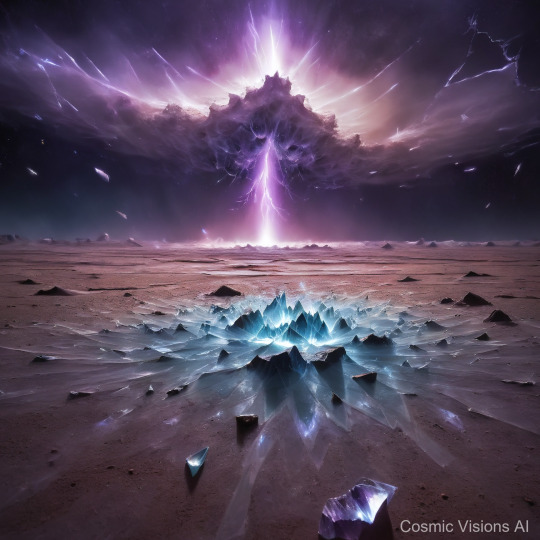
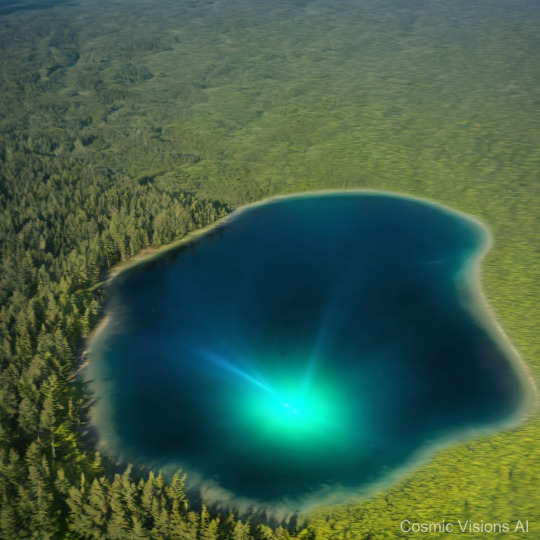
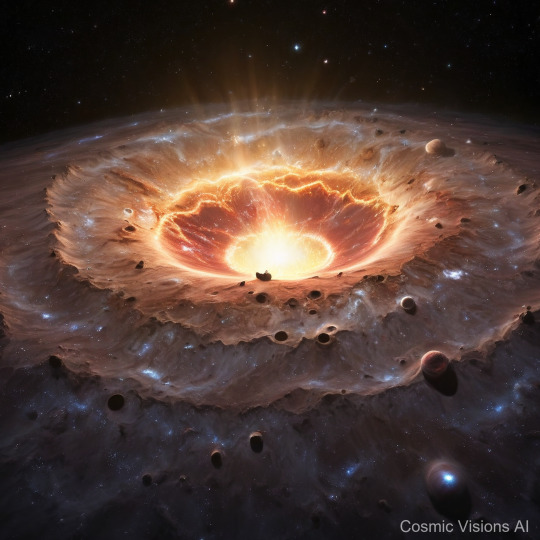
Planet Luminara, viewed from space, presents a swirling haze of iridescent blues and silvers, indicative of its thick, crystalline atmosphere which scatters light with a unique luminescence. Approximately 1.3 times the size of Earth, Luminara's gravity slightly exceeds what humans experience, influencing its peculiar geological structures. The surface of Luminara, characterized by its whispering crystal forests, boasts vast expanses of translucent trees—structures formed from silicon-based minerals. These crystal forests refract Luminara’s twin suns, creating a kaleidoscope of perpetual rainbows that dance across the landscape. Notably, the crystalline flora interacts with the planet's gentle breezes to produce melodic tones that resonate throughout the eerie terrain. Temperature fluctuations intensify the visual and auditory spectacle, as nightly freezes followed by rapid thawing at dawn cause the forests to subtly shift and chime. The combination of visual and auditory experiences makes Luminara a planet of haunting beauty and scientific fascination.
#WhisperingCrystalForests#DeepSpacePhotography#GalacticTrees#CosmicMagic#StarGazing#SpaceExploration#NebulaWhispers#CelestialBeauty#InterstellarDreams#GalaxyObsessed
0 notes
Photo
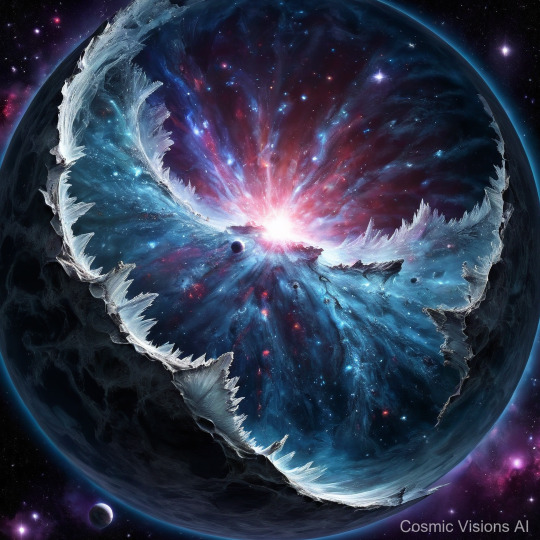
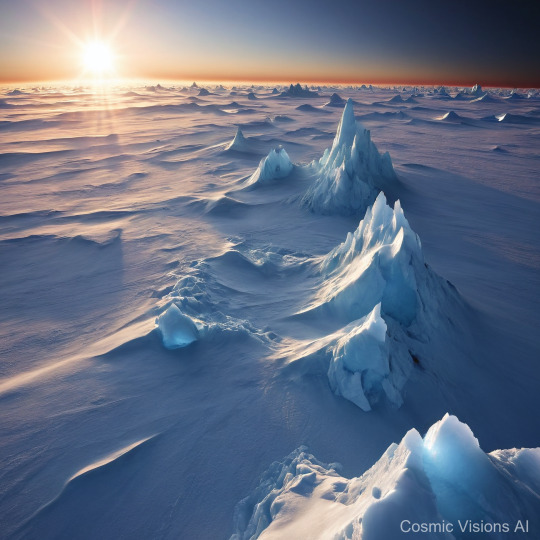
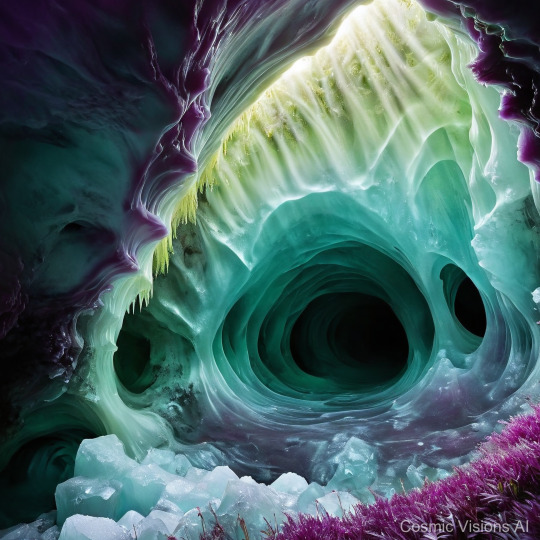
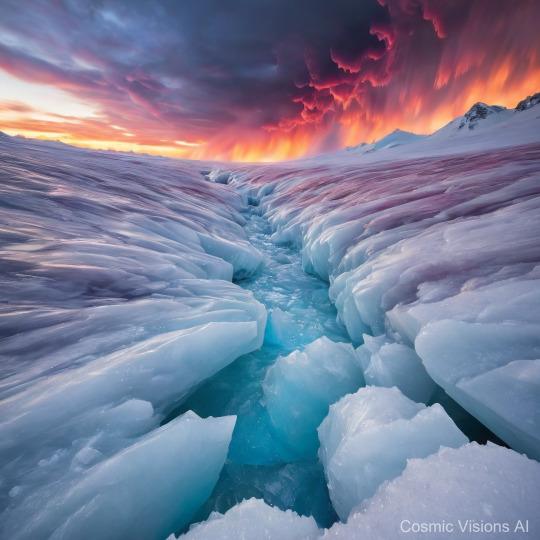
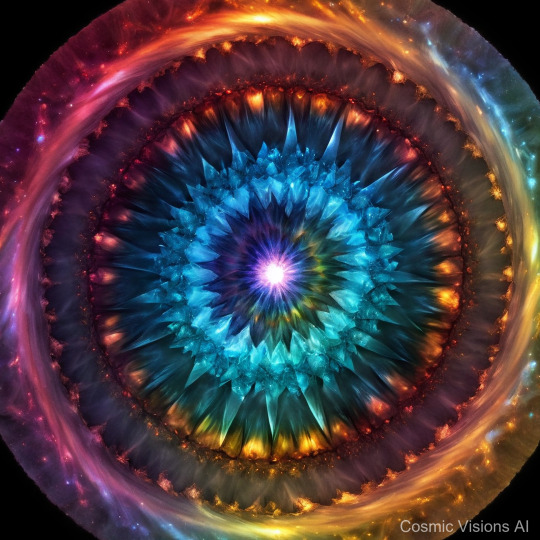
Planet Glacius Exterus, when viewed from orbit, reveals a mesmerizing vista with radiant bluish hues and widespread, shimmering white caps reminiscent of frost. This celestial body, slightly smaller than Earth, boasts an atmosphere tinged with light azure gases swirling amidst the constant chill of its environment. The surface of Glacius Exterus is dominated by expansive crystal ice peaks that rise sharply from the icy plains, their jagged contours sculpted by relentless subzero winds. These peaks, some reaching kilometers in height, glisten under the dim light of a distant sun, casting long, haunting shadows that creep across the frosted landscape. Temperatures perpetually hover far below freezing, creating an ever-present mist that softly blankets the ground, adding to the planet’s eerie, untouched splendor. Embedded within this icy terrain are pools of profoundly cold liquid, their surfaces occasionally disturbed by the slow dance of thin ice sheets. The raw beauty of Glacius Exterus remains pristine and formidable in the vastness of space.
#CrystalIcePeaks#SpaceCrystals#IceMountainStars#GalacticGlaciers#CelestialIceFormations#DeepSpacePhotography#FrozenWorlds#AstroIcicles#NebulaicPeaks#SpaceGems
0 notes
Photo
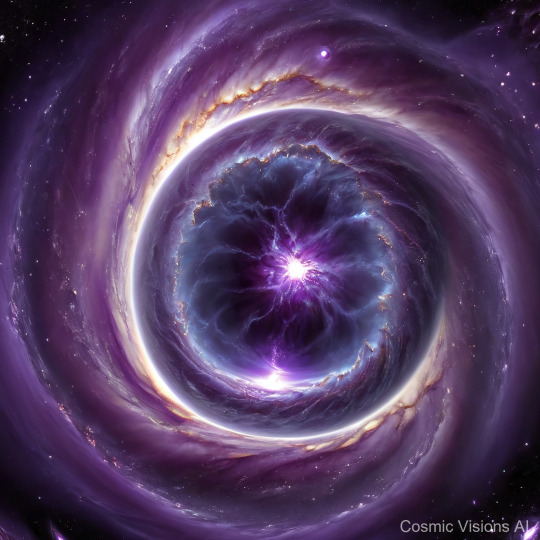
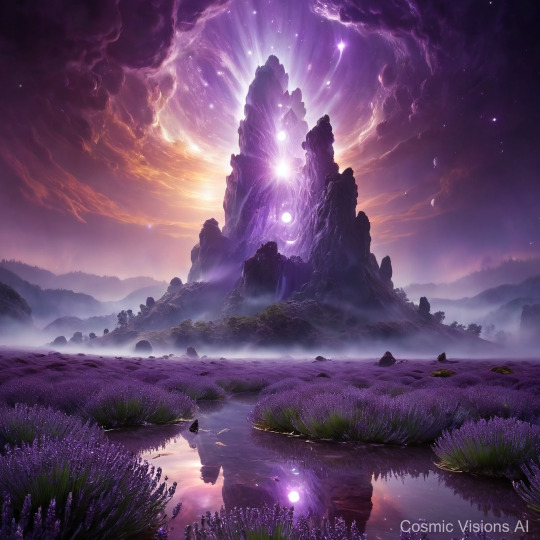
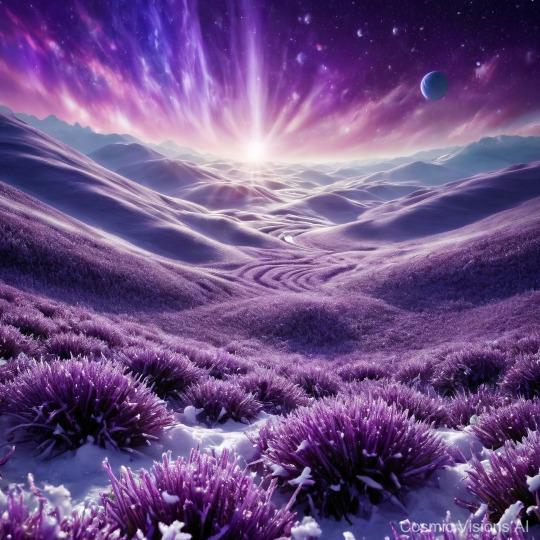
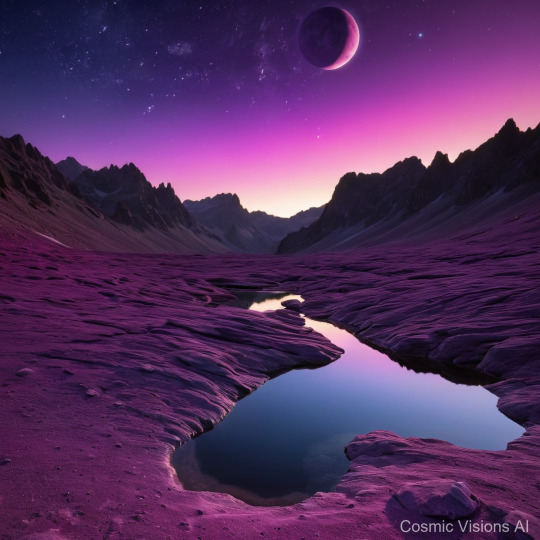
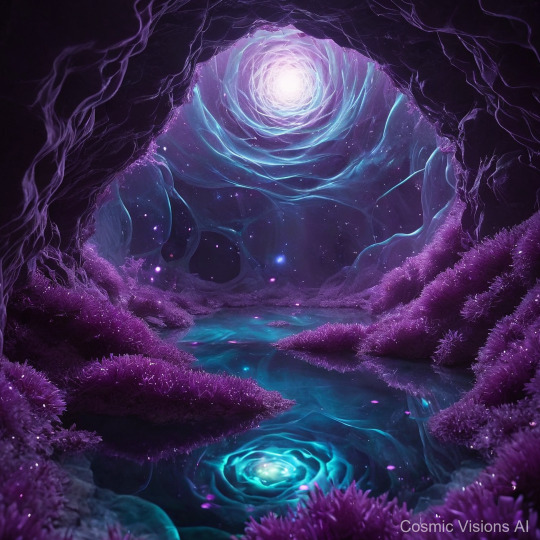
Planet Xylophane is distinguished by its vivid violet hue, visible from space, caused by its unique atmosphere rich in argon and neon. The planet is slightly larger than Earth, with a predominantly rocky surface interspersed with remarkable violet crystal springs that dominate the landscape. The surface imagery reveals that these springs are not only a defining visual feature but also a geological one. Crystalline formations around the springs emit a gentle luminescence, creating an ethereal glow that can be seen during the planet’s prolonged twilight hours. The luminescence is the result of photonic interactions within the crystal lattice, enhanced by Xylophane's thinner atmosphere, which consists of 72% nitrogen and 26% oxygen with traces of rare gases. The climate is marked by sharp temperature fluctuations, which contribute to the growth cycles of the crystals, affecting their color intensity and luminosity. Exploratory data suggests variable atmospheric pressures across different regions, which likely influences the crystallization process, giving rise to this planet's spectacular and colorful geological phenomena.
#VioletCrystalSprings#SpaceGems#CosmicWonders#StarrySkies#GalacticGlow#CelestialBeauty#NebulaDreams#AstronomyArt#DeepSpacePhotography#PurpleHues
0 notes